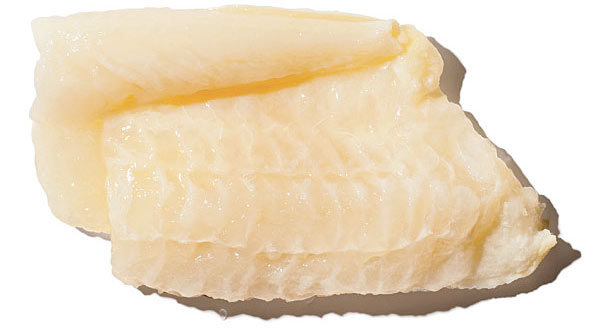
It’s just after 11 a.m. in a church basement in DeForest, Wisconsin, and I am face to face with one of the whitest plates of food I’ve seen in my life. I have tracked down the holiday dinner of my childhood, lutefisk—a jiggling, odd-smelling fish with the consistency of Jell-O, drenched in butter and nestled on a bed of whipped potatoes. Oh, brother, have I found it.
Traditionally, lutefisk is cod preserved in lye and, when needed, reconstituted with water to remove the toxic preservative. The bland fishy goo that remains is technically food, but it’s more of an Arctic Circle survival technique than a culinary achievement. As a child of Swedish descent, I grew up on stories of my great-grandfather eating pails of the stuff, cold, in front of the TV.
Of course, I’m not alone in this ritual. Scandinavians surround me at Christ Lutheran Church, happily shoveling down lutefisk, potatoes, and lefse (Norwegian potato bread), doused with a pitcher of melted butter. Despite not knowing one another’s names, we eat family-style, chatting between bites of mashed rutabaga and sips of coffee. The topic of conversation? Lutefisk. Two elderly sisters tell me how to make a lutefisk taco (wrap lutefisk and potato in lefse and drench it with butter); the young mother across from me wrangles her kids into eating more lutefisk, a surprisingly easy task.
One of the banquet’s co-chairs, Jan Scholz, has been hosting these dinners, with a staff of volunteers, since 1978. Back then, Scholz, of German and Dutch descent, didn’t even know what lutefisk was; now she loves it. In fact, the custom has become so ingrained in her life that potential spouses are told: If you want to be part of the family, you’re helping with the lutefisk dinner.
Dan Paulson, the other cochair and fishmaster in chief, runs the kitchen. He’s related to Scholz by marriage, his sons help cook the fish, two siblings help on the floor, and his sister-in-law seated me. He came to lutefisk as I did: “My father sat to my left, my uncle to the right. I couldn’t stand the stuff . . . but all that [lutefisk] passing underneath my nose, it killed enough taste buds that I started eating.” Paulson bought 2,200 pounds of fish and began watering it down five days before the banquet. The night before the event, he chopped it into five-inch chunks to boil the next day to feed about 1,350 congregants. Through ticket sales, the banquet nets a few thousand dollars, which goes to the church.
Lutheranism isn’t a prerequisite to lutefiskism. Fifty miles to the south, in Janesville, the Sons of Norway feed hungry Scandinavians a buffet of lutefisk, potatoes, and rommegrot. A cross between pudding and Spackle, rommegrot is heavy cream cooked down with flour until it thickens. Then it is dusted with brown sugar or cinnamon and sugar. Alongside lutefisk and lefse, it makes perfect sense.
Bonnie Forslund has run this dinner for the past 13 years. “It’s a dying art, really. We’ll do it until some younger generation comes up and says they’ll take over.” If lutefisk survives, it will be in part because the brainwashing begins early. “One family brought the baby last year,” Forslund says. “He was sitting in his highchair, eating lutefisk.”
Whether lutefisk is good or terrible is beside the point. Questions of taste go by the wayside when a single dish can take you back not only a quarter-century to your childhood but further—hundreds of years, to a homeland you’ve never seen and ancestors you’ve never met. When I sat down to that colorless, textureless plate of food, I felt closer to my grandparents than I had in years. Those feelings are worth a few pinbones and the scent of lye.
If you need a lutefisk fix and can't wait until Christmas, here is a local source for the, uh, delicacy: Erickson's Delicatessen, 5250 N. Clark St.; 773-561-5634.
Photograph: Anna Knott


